Discover the essentials of choosing safe, comfortable, and practical sleepwear for your baby․ Learn about materials, styles, and tips to ensure restful sleep and happy mornings․
Understanding the Importance of Sleep for Babies
Sleep is crucial for a baby’s development, growth, and overall health․ Newborns sleep 14-20 hours daily, with patterns improving by 3 months․ Quality sleep supports brain development, physical growth, and emotional well-being․ A consistent sleep routine helps babies feel secure, promoting better rest․ Ensuring a safe and comfortable sleep environment is vital for their safety and development․ Proper sleepwear plays a key role in maintaining the right body temperature and comfort, fostering uninterrupted sleep․ Prioritizing sleep helps babies thrive, making it a cornerstone of their care․ By understanding these needs, parents can create routines that support healthy sleep habits․
Overview of Baby Sleepwear Options
Baby sleepwear comes in various styles to suit different needs and preferences․ Footed onesies and rompers offer full-body coverage, while sleep sacks and swaddle blankets promote safe sleep practices․ Gowns and nightdresses are ideal for easy changes, and two-piece pajamas provide flexibility․ Each option caters to specific age groups, ensuring comfort and practicality․ Parents can choose between lightweight fabrics for summer and thermal options for winter․ Sleepwear also includes features like built-in mittens and hats for added convenience․ With so many options, selecting the right sleepwear involves considering factors like safety, comfort, and ease of use to meet a baby’s unique requirements․
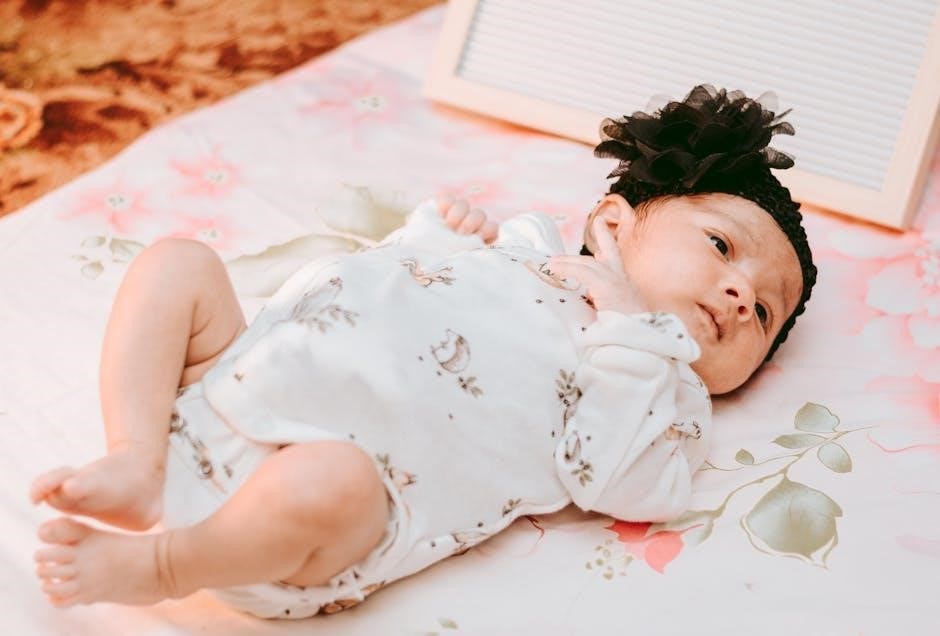
Factors to Consider When Choosing Baby Sleepwear
Consider breathability, softness, and safety․ Opt for flame-resistant fabrics, avoid harmful chemicals, and ensure ease of diaper changes․ Prioritize comfort and growth-friendly designs for your baby․
Material Safety and Breathability
Choosing sleepwear made from safe, breathable materials is crucial for your baby’s comfort and well-being․ Opt for natural fabrics like cotton, bamboo, or organic blends, which allow airflow and prevent overheating․ Avoid synthetic materials that trap heat and moisture․ Ensure the fabric is free from harmful chemicals by selecting GOTS or OEKO-TEX certified options․ Breathability is key to regulating body temperature, reducing the risk of overheating, which can be linked to SIDS․ Soft, non-irritating textures promote gentle skin contact, while moisture-wicking properties keep your baby dry and comfortable throughout the night․ Always prioritize materials that balance safety, softness, and breathability․
Comfort and Fit for Different Ages
Ensuring your baby’s sleepwear provides optimal comfort and fit is essential for different developmental stages․ For newborns, snug-fitting garments offer a sense of security, while older babies need room for movement․ Soft, stretchy fabrics accommodate growth spurts and active limbs․ Adjustable features like snap closures allow for a customizable fit as your baby grows․ Proper fit prevents restrictions, promoting healthy development․ Look for age-specific designs that cater to changing needs, ensuring comfort without compromising safety․ A well-fitting sleepwear promotes better sleep quality and supports your baby’s physical and emotional well-being at every stage․
Seasonal Appropriate Fabrics
Choosing seasonal fabrics ensures your baby stays comfortable year-round․ For winter, opt for warm, breathable materials like merino wool or thermal cotton․ Summer calls for lightweight, moisture-wicking fabrics such as bamboo or organic cotton․ During transitional weather, layers of soft fleece or blend materials provide versatility․ Always select fabrics that regulate body temperature and prevent overheating․ Natural fibers are ideal as they allow skin to breathe, reducing the risk of irritation․ Correct fabric choices adapt to changing seasons, keeping your baby cozy and safe, while promoting restful sleep regardless of the weather outside․
Practicality and Ease of Use
Practicality is key when selecting baby sleepwear․ Look for designs that simplify diaper changes and everyday care, such as snap fasteners or zippers that allow easy access․ Two-piece pajamas offer flexibility, while footed onesies provide convenience without losing socks․ Machine-washable fabrics are essential for busy parents, ensuring hygiene and longevity․ Sleepwear with minimal buttons or complicated fastenings reduces hassle, making late-night changes stress-free․ Opt for breathable, moisture-wicking materials to keep your baby comfortable․ Durable stitching and soft seams further enhance practicality․ Prioritizing ease of use ensures both you and your baby enjoy a seamless, stress-free experience․
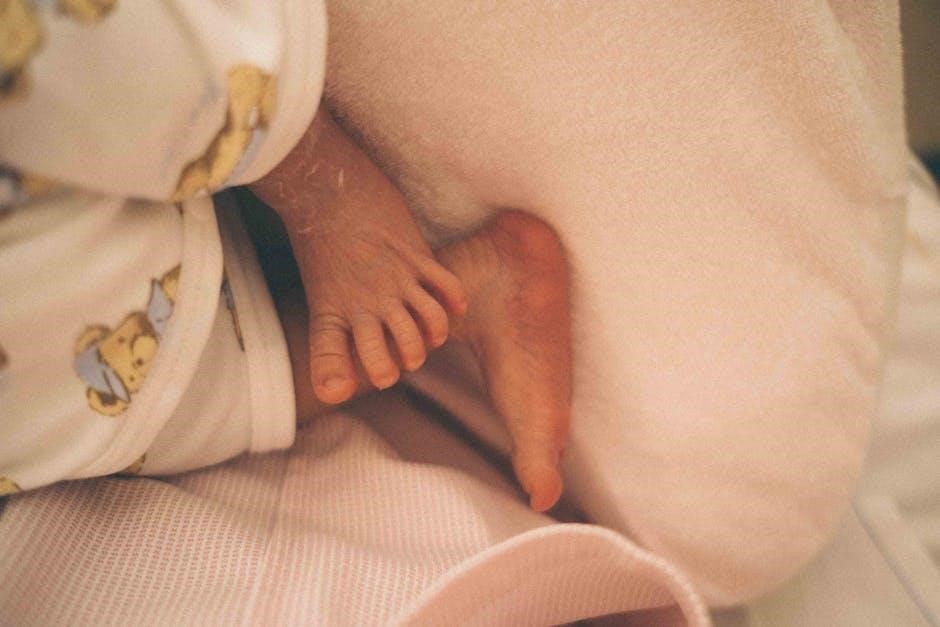
Safety Considerations for Baby Sleepwear
Ensure sleepwear meets safety standards, avoiding tight fabrics that pose suffocation risks․ Opt for flame-resistant materials and avoid harmful chemicals to prioritize your baby’s well-being and safety․
Flame Resistance and Safety Standards
Ensuring your baby’s sleepwear meets flame resistance and safety standards is crucial․ Look for garments made from inherently flame-resistant materials or treated with safe, non-toxic chemicals․ Tight weaves and secure stitching can prevent loose threads that may ignite․ Always check for certifications from reputable organizations, such as the U․S․ Consumer Product Safety Commission․ Avoid loose-fitting or overly decorative sleepwear that could pose a fire hazard․ Opt for sleepwear designed with safety in mind, ensuring it adheres to current regulations and guidelines․ Prioritizing flame resistance helps protect your baby while they sleep peacefully․
Risks of Tight Clothing and Suffocation
Tight clothing can pose serious risks to your baby, including suffocation and restricted movement․ Overly snug sleepwear may obstruct breathing, especially around the neck and chest․ Ensuring a proper fit is essential to prevent such dangers․ Avoid garments with tight collars or elastic bands that could compress your baby’s airways․ Opt for breathable, non-restrictive fabrics that allow for natural movement․ Additionally, check for any small parts or accessories that could detach and pose a choking hazard․ Always prioritize loose-fitting, comfortable sleepwear to safeguard your baby’s safety and promote healthy sleep patterns․
choosing Sleepwear Without Harmful Chemicals
Choosing Sleepwear Without Harmful Chemicals
Selecting sleepwear free from harmful chemicals is crucial for your baby’s health․ Opt for organic, non-toxic materials like cotton or bamboo, which are naturally gentle on skin․ Avoid fabrics treated with chemicals like formaldehyde or phthalates, often used in finishes․ Look for certifications like GOTS or Oeko-Tex, ensuring safety standards․ Wash new sleepwear before use to remove potential residues․ Prioritize breathable, hypoallergenic fabrics to minimize irritation and promote healthy skin․ By choosing chemical-free sleepwear, you create a safer environment for your baby to rest and thrive․
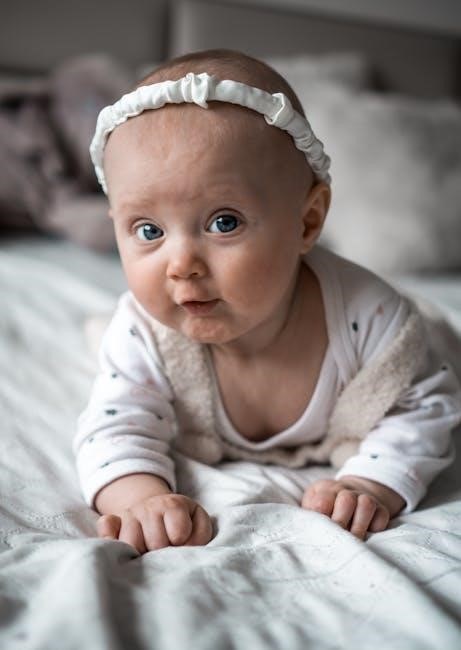
Types of Baby Sleepwear
Explore various sleepwear options, including footed onesies, sleep sacks, gowns, and two-piece pajamas, each offering unique benefits for comfort, ease, and seasonal adaptability․
Footed Onesies and Rompers
Footed onesies and rompers are popular choices for baby sleepwear, offering ease of movement and warmth․ They often feature built-in feet, eliminating the need for separate socks․
These designs are ideal for active babies, as they allow for comfortable crawling and stretching․ Many parents appreciate the practicality of snap closures, making diaper changes effortless․
Footed onesies are suitable for cooler months, while lightweight rompers are perfect for warmer weather․ Opt for soft, breathable fabrics like cotton or bamboo for optimal comfort․
These styles are versatile and can transition from sleep to play, making them a staple in any baby’s wardrobe․
Sleep Sacks and Swaddle Blankets
Sleep sacks and swaddle blankets are popular choices for newborns and young infants, promoting a sense of security and comfort․
They mimic the womb environment, helping babies self-soothe and sleep more soundly․
Sleep sacks are designed with arm holes or without sleeves, allowing for easy movement while keeping the body warm․
Swaddle blankets, on the other hand, can be wrapped snugly around the baby, though care must be taken to avoid overheating or tightness․
Opt for lightweight, breathable fabrics like muslin or bamboo for warmer months, and thermal options for colder weather․
Many sleep sacks feature zippers for easy changes, making them a practical choice for parents․
They are especially useful during the first few months when babies benefit from the feeling of being swaddled․
Gowns and Nightdresses
Gowns and nightdresses are charming and comfortable options for baby sleepwear, perfect for both warmth and ease․
These designs often feature a loose, flowing fit with elastic bottoms for a snug and secure feel․
They are ideal for cooler climates, as they allow for layering without restricting movement․
Many gowns have sweet embellishments like lace or embroidery, adding a touch of style․
Nightdresses typically have a more streamlined design, focusing on comfort and simplicity․
Both options are easy to change, making them a practical choice for busy parents․
They are also gentle on sensitive skin, ensuring a peaceful night’s sleep․
Two-Piece Pajamas
Two-piece pajamas, consisting of a top and bottoms, offer ease of use and flexibility for baby sleepwear․
They are ideal for parents who prefer separates for quick changes and layering․
Soft, breathable fabrics like organic cotton or bamboo ensure comfort and skin safety․
Elastic waistbands provide a snug fit without irritation, while snap closures simplify diaper changes․
Seasonal designs cater to different weather conditions, with thicker fabrics for winter and lightweight materials for summer․
Two-piece sets are practical, allowing for easy mixing and matching of styles․
They are a popular choice for their versatility and ease of care, making them a must-have in any baby’s wardrobe․
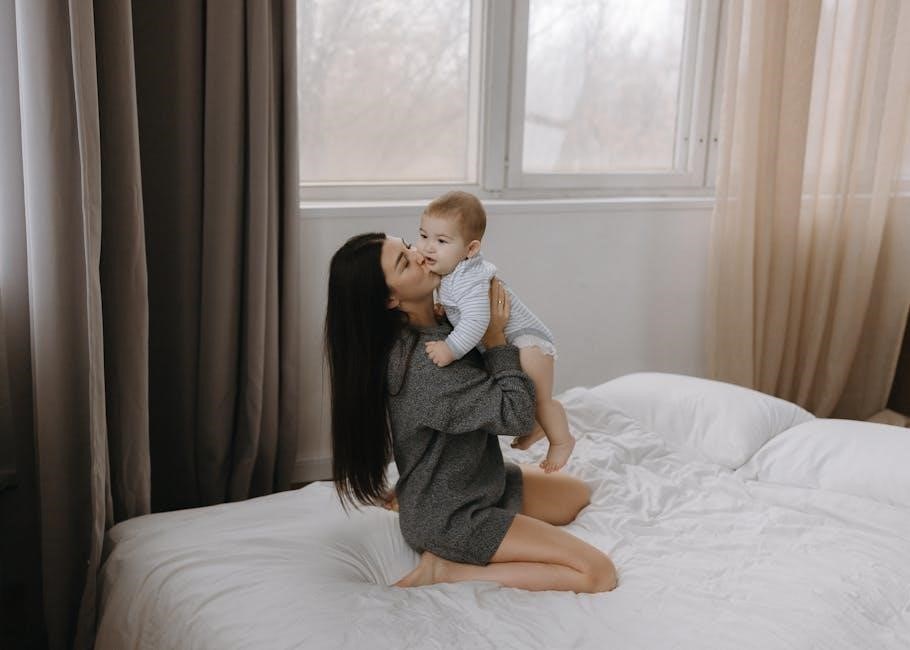
Seasonal Sleepwear Guide
Choose sleepwear based on the season for optimal comfort․ Winter calls for thermal layers, summer for lightweight fabrics, and transitional weather for adaptable materials like merino wool or fleece․
Winter Sleepwear: Thermal and Layering Options
For colder months, opt for thermal sleepwear made from breathable, insulating fabrics like merino wool or fleece․ These materials keep baby warm without overheating․ Layering is key—pair a thin onesie with a heavier sleep sack or footed romper․
Look for sleepwear with built-in footed designs to prevent chilly toes․ Ensure a snug, comfortable fit to avoid drafts․ Consider sleep sacks with adjustable layers for versatility․ Always check for flame-resistance and avoid loose fabrics to reduce safety risks․ A well-chosen winter sleepwear set ensures your baby stays cozy and safe throughout the night․
Summer Sleepwear: Lightweight and Breathable Fabrics
Keep your baby cool and comfortable during summer nights with lightweight, breathable fabrics like organic cotton, bamboo, or muslin․ These materials wick moisture and allow airflow, preventing overheating․
Opt for sleeveless or short-sleeve designs to enhance ventilation․ Footed rompers can be replaced with non-footed options or simple cotton gowns․ Sleep sacks made from lightweight, breathable fabrics are ideal for warm weather․ Avoid synthetic materials that trap heat․ Always dress your baby in layers that can be easily adjusted as room temperatures change․ Prioritize soft, natural fabrics to ensure your baby’s skin stays dry and comfortable throughout the summer months․
Transitional Weather Sleepwear
For seasons with fluctuating temperatures, transitional sleepwear offers versatility․ Opt for lightweight, breathable fabrics like organic cotton or bamboo that regulate body heat․ Sleep sacks with adjustable layers or removable sleeves are ideal, allowing easy adaptation to changing conditions․ Footed rompers made from medium-weight fabrics provide warmth without overheating․ Ensure materials are free from harmful chemicals for safety․ Layering is key—use a thin base layer paired with a breathable sleep sack․ This approach keeps your baby comfortable during spring or fall, ensuring restful sleep without compromising on style or practicality․
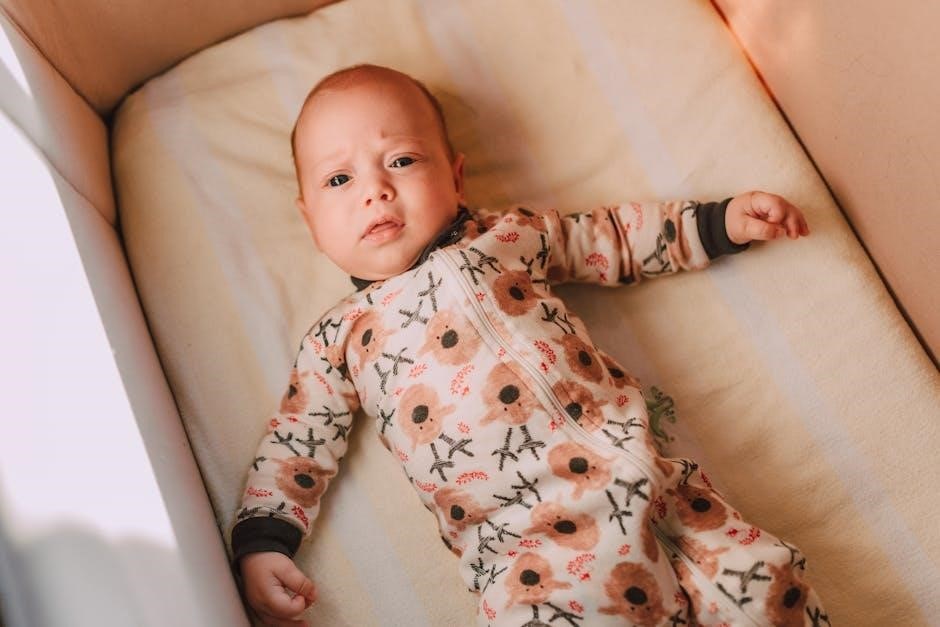
Sizing and Fit
Proper sizing ensures comfort and safety․ Measure your baby accurately, and refer to size charts for the best fit․ Adjustable features like snaps and stretchy materials help accommodate growth spurts, ensuring sleepwear remains comfortable without being too tight or restrictive․
How to Measure for Proper Fit
Ensuring your baby’s sleepwear fits correctly is crucial for comfort and safety․ Start by measuring their chest circumference, as this is the primary sizing factor for most garments․ Use a flexible tape measure, placing it under the armpits and around the broadest part of the chest․ For length, measure from the base of the neck to the desired pant or gown length․ Consider weight and height charts for additional guidance․ Always check the manufacturer’s size chart, as measurements can vary between brands․ Proper fit allows for ease of movement and avoids tight clothing risks, ensuring safe and restful sleep for your baby․
Size Charts and Age Recommendations
Size charts for baby sleepwear typically organize sizes by age, weight, and height, helping parents select garments that fit appropriately․ These charts often include ranges to accommodate growth spurts․ For example, a 6-month size might fit babies weighing 16-22 pounds and measuring 26-28 inches tall․ Age recommendations are general guides, as babies develop at different rates․ Always cross-reference your baby’s measurements with the chart to ensure the best fit․ Remember, proper fit is key for comfort and safety․ If in doubt, size up to allow room for movement and growth, ensuring your baby sleeps comfortably and securely․
Adjusting for Growth Spurts
Babies grow rapidly, making frequent adjustments to sleepwear necessary․ Monitor your baby’s measurements regularly to ensure garments remain comfortable and safe․ Look for sleepwear with adjustable features, such as snap closures or stretchy fabrics, to accommodate growth spurts․ Seasonal changes may also require updating sleepwear to maintain the right temperature․ Keep a few sizes on hand to transition smoothly as your baby grows․ Proper fit is crucial for comfort and safety, so check for snug but not tight clothing․ Regularly updating sleepwear ensures your baby sleeps soundly and comfortably throughout their developmental stages․
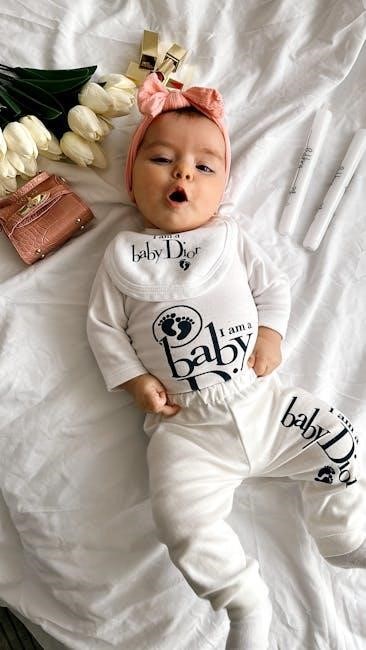
Caring for Baby Sleepwear
Keep your baby’s sleepwear clean and hygienic by washing regularly, using gentle detergents, and avoiding harsh chemicals․ Dry naturally to preserve softness and fabric integrity for long-lasting comfort․
Washing and Sanitizing Guidelines
Properly washing and sanitizing baby sleepwear is crucial for maintaining hygiene and comfort․ Always use gentle, fragrance-free detergents to avoid irritating your baby’s sensitive skin․ Wash sleepwear separately from other laundry to prevent cross-contamination․ For delicate fabrics like cotton or bamboo, opt for a cold water cycle to preserve softness and prevent shrinkage․ Sanitize by adding a 1/2 cup of white vinegar during the rinse cycle, which naturally eliminates bacteria without harsh chemicals․ Avoid using fabric softeners or bleach, as they can leave residues․ Dry sleepwear on a low heat setting or air-dry to maintain fabric integrity․ Regular washing ensures freshness and safety for your baby․
Drying and Storing Sleepwear
After washing, dry baby sleepwear on a low heat setting or air-dry to prevent shrinkage and maintain fabric softness․ Avoid high heat, as it can damage delicate materials or cause tightness․ Once dry, store sleepwear in a cool, dry place to prevent moisture buildup․ Use breathable storage containers like fabric bins or baskets to maintain airflow․ Fold or hang items neatly to prevent wrinkles and creases․ Organize sleepwear by size and type for easy access․ Ensure all pieces are completely dry before storing to avoid mildew․ Regularly check stored sleepwear for stains or wear to ensure quality and safety for your baby․
Fabric Care Tips for Longevity
To maintain the quality of baby sleepwear, wash items in a gentle cycle with mild detergents․ Avoid using fabric softeners or bleach, as they can irritate sensitive skin or damage materials․ Remove stains promptly with a soft brush or clean cloth․ Dry on a low heat setting or air-dry to prevent shrinkage․ Store sleepwear in a cool, dry place to avoid moisture buildup․ Use breathable storage containers to maintain fabric health․ Check care labels for specific instructions, as some fabrics may require special handling․ Regularly inspect for wear and tear to ensure longevity and safety for your baby․

Additional Features to Look For
Enhance your baby’s comfort and safety with features like built-in mittens, hoods, and adjustable snaps․ These details ensure practicality and adaptability for growing needs and seasons․
Snaps and Zippers: Ease of Use
Snaps and zippers are essential features in baby sleepwear, offering convenience for parents during late-night changes․ Snaps are often preferred for their ease of use and durability, while zippers provide a quick and straightforward way to dress or undress your baby․ However, it’s important to ensure zippers are sturdy and won’t catch delicate skin․ Opt for sleepwear with easy-to-grip snaps or smooth-gliding zippers․ Consider your baby’s age and your personal preference when choosing between these options․ Properly designed closures can make a significant difference in the practicality of baby sleepwear, ensuring comfort and safety for your little one․
Footed vs․ Non-Footed Sleepwear
Choosing between footed and non-footed sleepwear depends on your baby’s needs and the season․ Footed options, like onesies or rompers, keep legs and feet warm, ideal for colder months․ They also prevent socks from slipping off, ensuring tiny toes stay cozy․ Non-footed sleepwear offers more flexibility, allowing for layering with socks or leggings, which is perfect for transitional weather․ Consider your baby’s activity level and room temperature when deciding․ Both styles are practical, but footed sleepwear is often preferred for younger infants, while non-footed options suit older babies who may prefer more freedom of movement during sleep․
Built-In Mittens and Hats
Built-In Mittens and Hats
Built-in mittens and hats in baby sleepwear are designed to provide convenience and comfort․ Mittens prevent babies from scratching their faces, while hats help retain body heat, especially in colder environments․ These features are particularly useful for newborns and young infants who have delicate skin and limited ability to regulate temperature․ Look for sleepwear with soft, breathable materials to ensure your baby stays comfortable․ These additions can also save time during bedtime routines, as they eliminate the need for separate accessories․ Opt for styles with easy-on-and-off designs to maintain practicality while changing diapers or adjusting your baby’s clothing as needed․
Establishing a Bedtime Routine
A consistent bedtime routine helps babies sleep better․ Include a calming environment, predictable schedules, and cozy sleepwear to signal bedtime, promoting relaxation and better sleep quality․
Creating a Soothing Environment
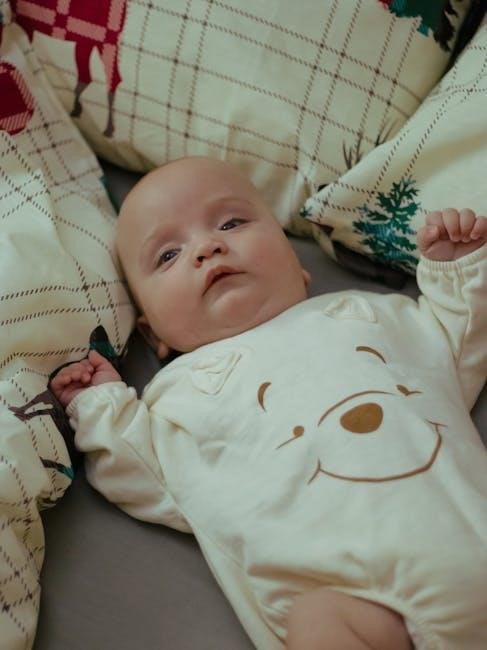
Creating a soothing environment is crucial for your baby’s sleep․ Ensure the room is dimly lit, with a comfortable temperature between 68-72°F․ Use white noise machines or soft lullabies to mask disturbances․ A calm atmosphere helps your baby relax, making it easier to fall asleep․ Incorporate a consistent bedtime routine, such as a warm bath or a gentle massage, to signal sleep time․ The right sleepwear, like breathable fabrics and snug fits, complements this environment, promoting comfort and security․ A peaceful setting, combined with cozy sleepwear, fosters better sleep quality and helps your baby sleep more soundly through the night․
Consistency in Sleep Schedules
Consistency in sleep schedules is vital for your baby’s development and sleep quality․ Establishing a predictable bedtime routine helps regulate your baby’s internal clock, making it easier for them to fall asleep and stay asleep․ A consistent schedule ensures your baby gets adequate rest, which is essential for growth and cognitive development․ Over time, this routine becomes a comforting signal, reducing resistance to bedtime․ By maintaining a steady sleep schedule, you also help your baby adapt to changes, like travel or transitions, more smoothly․ Consistency creates a foundation for healthy sleep habits that benefit your baby throughout childhood․
Role of Sleepwear in Bedtime Routine
Sleepwear plays a significant role in establishing a soothing bedtime routine for your baby․ Comfortable, breathable fabrics and snug fits help your baby relax, signaling that it’s time to sleep․ Choosing sleepwear that aligns with the season ensures your baby isn’t too hot or cold, promoting better rest․ Additionally, sleepwear with features like built-in mittens or footed designs can reduce irritants, allowing your baby to focus on sleeping․ By incorporating thoughtful sleepwear into your routine, you create a calming environment that supports consistent and restful sleep, fostering healthy sleep habits from an early age․
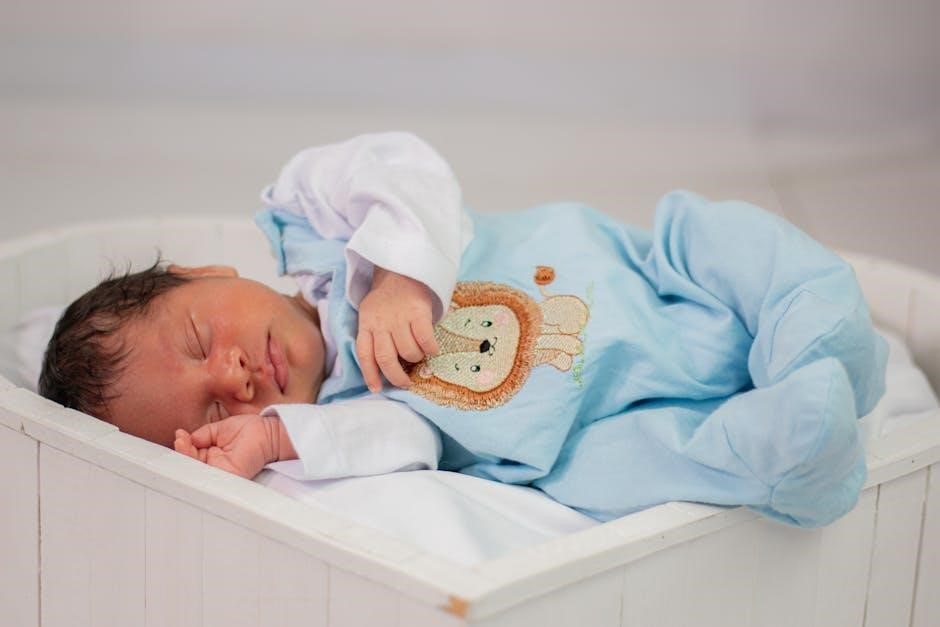
Popular Brands and Recommendations
Top-rated brands like Woolino and Halo offer safe, cozy sleepwear․ Parents praise their breathable materials and practical designs, ensuring comfort and safety for babies of all ages․
Top-Rated Sleepwear Brands
When it comes to baby sleepwear, trusted brands prioritize safety, comfort, and quality․ Pajama Sutra is renowned for its soft, organic fabrics and stylish designs․ Halo Sleep is a favorite for its flame-resistant, chemical-free options․ Burt’s Bees Baby offers sustainable, eco-friendly sleepwear․ These brands consistently receive high ratings from parents for their attention to detail and commitment to safety standards․ They use breathable materials and gentle textures, ensuring your baby sleeps comfortably․ Whether you’re looking for footed onesies or sleep sacks, these top-rated brands provide reliable choices for every season and stage of your baby’s growth․
Parent-Approved Sleepwear Options
Parents often recommend sleepwear that balances practicality and comfort․ Footed rompers with snap closures are popular for easy diaper changes․ Sleep sacks like the Woolino are praised for their versatility during temperature changes․ Adorable gowns with mittens are perfect for newborns, while two-piece pajamas offer flexibility for growing babies․ Many parents swear by Bamboo Baby for soft, breathable fabrics․ These options are tested and loved, ensuring your baby’s comfort and your peace of mind․ They are designed to meet the unique needs of little ones, making bedtime routines simpler and sleep more restful for the whole family․
Choosing the right sleepwear is crucial for your baby’s comfort and safety․ Opt for breathable fabrics, proper fit, and safety standards․ A well-rested baby means a happier family․ This guide helps you make informed decisions for safe and comfortable sleep․
Final Tips for Choosing the Best Sleepwear
Prioritize safety, comfort, and practicality when selecting baby sleepwear․ Opt for breathable, flame-resistant fabrics and avoid tight clothing to reduce suffocation risks․ Consider your baby’s age, season, and personal needs․ Check for certifications like AAP approval and read reviews for trusted brands․ Ensure easy-to-use features like snaps or zippers for quick changes․ Layering options can help adapt to changing temperatures․ Wash and maintain sleepwear properly to ensure longevity․ Ultimately, choose sleepwear that promotes safe, restful sleep and aligns with your baby’s unique preferences and growth stages․
Encouraging Safe and Comfortable Sleep
Creating a safe sleep environment is crucial for your baby’s well-being․ Ensure the crib is free from soft bedding, toys, and loose blankets to reduce suffocation risks․ Use a firm mattress and tight-fitting sheet․ Dress your baby in appropriate sleepwear based on room temperature to prevent overheating․ Avoid overbundling, as it can increase the risk of SIDS․ Opt for sleep sacks or swaddles that allow for easy movement and maintain a comfortable body temperature․ Establish a consistent bedtime routine to signal sleep time, promoting better sleep quality and duration for your baby․
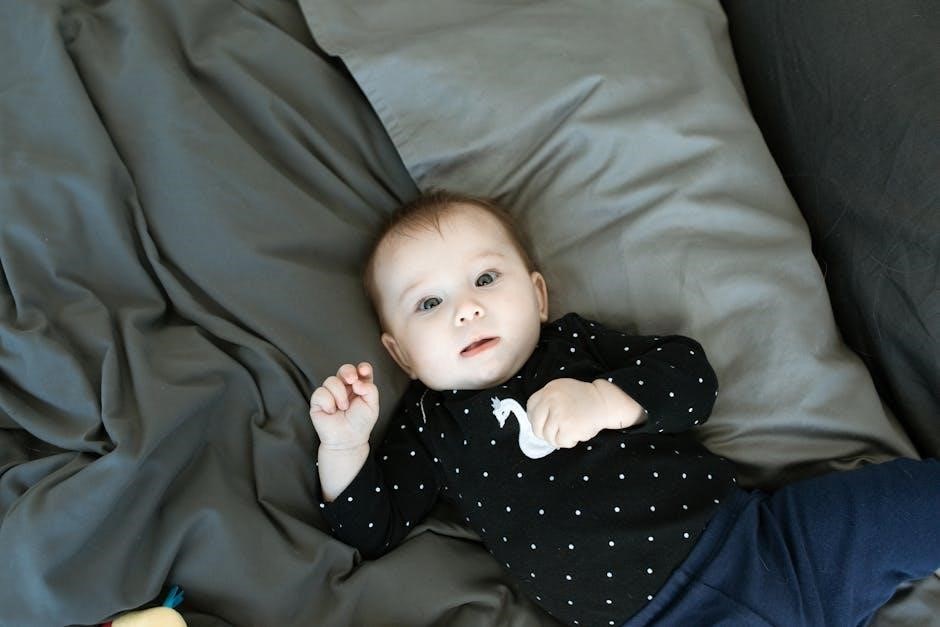
Be First to Comment